Coma: The Art of Unconsciousness
Pierre Guyotat's books break down language, bodies and the self to stage an estranged eternal present. Stephen Barber sifts through Guyotat's extraordinary history and prises apart the pages of his most recent work
Pierre Guyotat's Coma is a book of fragments that, in their amassing and accumulation, recount a narrative of simultaneous corporeal and linguistic disintegration and emaciation, in the form of a journey of hallucinations and travels undertaken through France, that leads towards a dead end: a near-fatal physical coma, and a terminal breakdown of language - which, through a further aberration (one of many to be experienced in Guyotat's work), eventually transmutates into the form of a book of resuscitation, and into a new language: Coma.
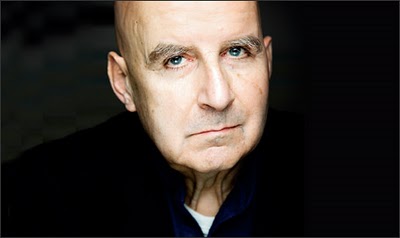
Image: Portrait of Pierre Guyotat
The timeframe of the book begins almost twenty years in the future from the moment of Guyotat's self-inflicted comatose state, so that we know immediately that the book projects itself as an act of survival as well as one of disintegration. In 1999 - at 'the close of one of the last afternoons of the last century of the millennium', as Guyotat writes - he and a companion attend a performance of Balinese dance. This was a re-creation of a 1931 performance at the Vincennes Colonial Exhibition (witnessed by the theorist Antonin Artaud), at a theatre in Paris. Their perspective onto the performance is askew: ‘Seated in the chamber of the red and gold hall, and to the right of the stage, we see the show at an angle: profiles of bodies, objects and instruments.' That askew and intermittent vision, obscured by obstacles and necessitating extreme effort on the part of the spectator, serves to intensify the spectacle, and mirrors the reader's experience of Coma itself: in many ways, that of unbearable physical meltdown, anguish and depression, plummeting beyond consciousness and impossible to grasp in its entirety, and, at the same time, a revelatory experience of language. Leaving the theatre after the performance, Guyotat witnesses a derelict writer of his own age, standing in the street and trying to sell shreds of paper inscribed with handwritten poems, and he observes that: 'That's me, really... that should be me... . That man is myself if I was not myself.' The last-gasp, end-of-millennium starting point of Coma, and of Guyotat's act of memory, backwards in time to the period of his physical and linguistic disintegration, is sparked by that mysterious vision of identicality. The itinerant writer who, in his dereliction, appears to be Guyotat, but is simultaneously not him, causes his memory to move through the scandals and legends unleashed by his own distinctive past history, thereby unpeeling him from that mirror image, so that the book is now able to begin.
In the Desert of Censorship
Guyotat has a unique position in French writing and theory through that distinctive background of scandal, censorship and legend; his work, suppressed for its perceived sexual and political outrages, had to be defended by many of the prominent European artists and theorists of the 1960s and 1970s: Pier Paolo Pasolini, Roland Barthes, Jean Genet, Michel Foucault and Jacques Derrida, among many others. Guyotat is the son of a mountain doctor, born in rural France in 1940: the year of the Fall of France to the invading German army, leading to the resistance activities and deportations to concentration camps which became an integral part of Guyotat's family history and of his developing consciousness, in which photographs of carbonised bodies beside extermination camp barbed wire fences (one reproduction of which appears in Coma) and photographs of pornography, passed hand to hand at his boarding-school, are formatively welded together. As a young man, Guyotat volunteered to become a French soldier in the war of colonial liberation in Algeria, and was arrested and imprisoned for his support of the Algerian rebels. Subsequently, he returned several times to Algeria, after it had gained independence from France, and travelled to other African countries, especially Niger, on precarious desert journeys which provided many of the locations - battlefields, wastelands and brothels - for his celebrated novels of the 1960s, Tomb for 500,000 Soldiers and Eden, Eden, Eden. In these books, Guyotat experimented both with the writing of death and sexuality, and also with the process of writing itself: Eden, Eden, Eden formed one, open ended, book length sentence, linguistically hypnotic and unstoppable in its relentless incantation of acts of torture, massacre and prostitutional sex. That novel, in particular, led to widespread social and political outrage and was placed under censorship measures for more than a decade, while the earlier Tomb for 500,000 Soldiers had an immense readership among the young students who attempted a street riot revolution in Paris in May 1968.
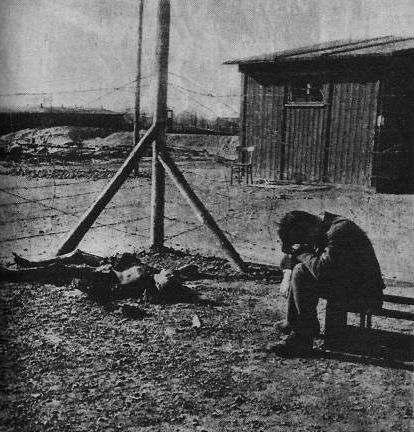
Image: Pierre Viannay, Freed young deportee in front of a carbonised comrade, 1946 (Bibliothéque Nationale de France)
Coma is positioned in the time period after those furores, when Guyotat had become a celebrated public figure, lauded by theorists such as Foucault and Barthes, and with a wide readership in France, but simultaneously a profoundly subterranean and near invisible one, living in poverty in the tiny, cemetery-adjoining apartment where he suffered his coma, or restlessly travelling in a camper van between the gardens of friends in rural southern France, living itinerantly and out-of-doors. He published only one novel in the 1970s - Prostitution, in which the corporeal obsessions and linguistic experimentation of Eden, Eden, Eden are exacerbated, and intercut with vocal shards from other languages, especially Arabic - but continued to work incessantly, with an accumulating, headlong velocity, while experiencing periods of depression and hallucination. The timescale of Coma is both that of the resulting end point of his calamitous overdrive, and also that of a moment in which time becomes stilled and malleable, and may be propelled infinitely, into the past or future.
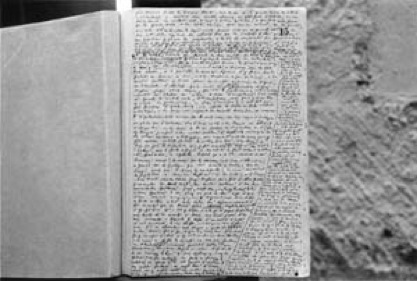
Image: Manuscript by Pierre Guyotat
Guyotat's own future, after the near-fatal breakdown period narrated in Coma, was one of gradual re-assembly and rehabituation to life. He published one of the two novels he had worked on in the period leading up to his coma, Le Livre (The Book), 1981, while the other novel, Histoires de Samora Machel (Stories of Samora Machel) remains unpublished; he began giving public readings, notably at the Centre Pompidou in Paris, as a kind of performance art, especially in the form of improvisations in which he invented narratives from scratch, often developing them across several hours' duration. He continues to publish intermittently in France, and his most recent book, Arrière-fond (Background), 2010, interrogates the sexual hallucinations he experienced during a journey as a youth to North East England in 1955. His status in France has, in some ways, reversed from that of the peripheral, obscene reputation he had in the early 1970s; Coma won a major French literary prize, and Guyotat is often presented as a last surviving avant-garde legend, in an era in which all other living French writers now appear banalised and consumerism-enslaved, by contrast with his particular history. The French national library, which holds his archives, is planning to digitise his manuscripts (many of them, especially from the early period of his work, imprinted with body fluids, especially semen), and his work has been translated in recent years into other languages, including Japanese, Russian and English; the Semiotext(e) edition of Coma cryptically offers no clues about this, so you would have to be psychic to know that Guyotat's seminal books, Tomb for 500,000 Soldiers and Eden, Eden, Eden, are readily available in English language translations, published in the UK respectively in 1995 and 2003, by Creation, and that extracts and fragments from Guyotat's work have appeared in English in journals of theory and poetry, such as the literary journal Curtains, as far back as the 1970s.
Figures in a Landscape
Coma is the story of a man who writes himself to death, but is brought back from death (Guyotat literally had to be resuscitated from a heart stopped state, in a hospital emergency room), and writes a book about the experiences - many of them experiences of ecstasy - that created that coma.
Only the final eight or so pages of the book concern Guyotat's coma, his experience of falling into it, the dreams and hallucinations (many of them indirectly filtered and re-figured from the corporeal and spatial occurrences in the hospital ward around him), and his gradual awakening, in which his self - the 'I' that narrates - is shattered. The remainder of the book constitutes the journey of Guyotat's disintegration, extending over several years but irrevocably heading towards his coma, as though all of his travels are undertaken and synchronised to give that fall beyond consciousness its maximum impact. As a result, the book forms a topographical exploration of landscape, with successive trajectories from location to location, by camper van, across southern France and the island of Corsica, layered over and into the intensive excoriation exacted by Guyotat on his own body, which becomes progressively more emaciated and fossilised during the course of those travels. He is always working outdoors, in open fields, fearing constraint and confinement, including literal incarcerations in clinics (in the early part of the book, his friends have him temporarily committed to a private psychiatric clinic in the Paris suburbs). He incorporates the landscape and its figures into his texts:
by moving my campsite around, I change my ground; I change my historical direction. In the work at hand, I change the very ground on which I settle... People that walk by, farmers toiling in fields around mine, children, animals, they enter my pages, transformed in time and space.
Coma's concentration on Guyotat's incessant journeys, narrated as fragmentary episodes, generates a mobile, mutating text within which the reader is always on slippery, displaced ground. Guyotat's journey of self-disintegration parallels that of Jean Genet, who travelled, mostly on foot, across Europe in the 1930s, crisscrossing the continent in solitude and exposure, including a traversal of Nazi Germany, begging, stealing and prostituting himself as he went, and eventually narrated that journey - in his book The Thief's Journal - as one which ultimately returned him to Paris, where he began his career as a criminal, poet and novelist. Genet, too, perceived a seminal, creative identicality between himself and the human figures he encountered, and wrote of being face-to-face in a train compartment with a decrepit, drooling old man, and feeling their identities exchange themselves, backwards and forwards, between their bodies. And as with Genet's nomadic and literally outlandish travels, Guyotat's journey finally returns him to Paris, but even there, he remains constantly on the move, as he walks the entire face of the city each night to locate pharmacies in which he is not known, and where he can purchase drugs that assist in the relentless stripping down of his self.
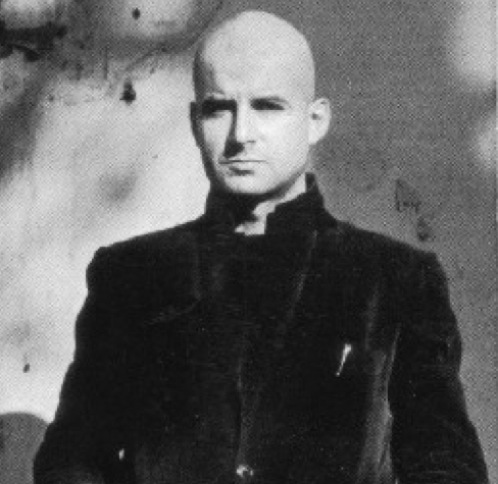
Image: Portrait of Pierre Guyotat
Coma is, above all, a book of hallucinations, and of the creative directing and wielding of hallucination as a disciplined act, into the form of language. In an interview from 2010, Guyotat noted: 'Hallucination is my natural state, but it's a kind of hallucination that I control.' However, the hallucinations in Coma, in the form of the passages Guyotat narrates from the journey that leads towards his breakdown, are often ones in which the hallucination is dangerously unstable, and jolts between media. While driving at night through rural France, he hallucinates while at the wheel, conjuring hordes of dogs which threaten to engulf him and can only be controlled, from within the hallucination, by a form of vocal outburst:
But in a village, where a spike of terror has made me stop and step out of the van, settle on a bench in the middle of the central square with its circle of insect-veiled street lamps, here they come lunging from all convergent avenues. As they pause, suddenly, in their charge, a cry rips out that I think might free me, but terrorises my own limbs instead. The dogs bolt in the opposite direction.
In another passage, Guyotat hallucinates while vomiting an overdose of drugs in the toilets located beneath a cinema auditorium; the film's cacophonic soundtrack is audible through the ceiling, and Guyotat immediately integrates it, along with sequences from the film, into the ongoing hallucinations for his writing process. The hallucinations he narrates in Coma are almost always in the medium of abrupt flashes, written in condensed form and separated from one another, so that the book itself often appears more a filmic rather than literary experience, comprising intensive, rapid bursts of probing and demanding imagery like those of experimental films by Kurt Kren and Stan Brakhage.
Much of the scandal attached to Guyotat's work in the 1960s and 1970s emerged from its pervasive sexual content, which led to parallels with the Marquis de Sade's novels, rather than to genres of erotic fiction; his novel Eden, Eden, Eden, written in 1968-69, recounted an unending, escalating succession of sexual acts between predominantly male prostitutes, overseers, clients, animals and inanimate objects in desert brothels, surrounded by an aura of warfare, and Guyotat's work in that era became so excessively and uniquely pornographic that its overkill served to destabilise and overturn the status of pornography itself. Guyotat viewed pornography as the emanation of society's power. Almost forty years on, in Coma, it is Guyotat himself who becomes the tentative protagonist for his book's sexual episodes, in which, for example, he encounters a young Algerian man on a building site in the desolate peripheries of Marseilles. But rather than the sexual act itself, he writes of the darkened, improvised surroundings in which it takes place, as though even the final gestures of sex undertaken by his ailing body, as it descends in emaciation towards its coma, are inflected by the abyss into which he is gradually falling:
he leads me, in a large warehouse area under renovation, up to a high building, gray and red, with a broken window from which tattered strips of black and khaki covers hang and flap. In a long hall with cast-iron pillars, where parts of the wood floor are rotting upon black earth, silhouettes, young, bundled-up, err from one pillar to another. At the end, on raised flooring and near a hole that a plank runs through - water, underneath, toilets or the sea? - are five, seven mats where other bodies sleep under covers, except for arms, bandaged or not.
Most of the episodes of Guyotat's corporeal and linguistic disintegration in Coma take place in isolation and solitude, including his final fall into a comatose state (only the chance intervention of a friend leads to his last-minute discovery and reanimation in hospital). Although the act of being humiliated - sexually or otherwise - or of self-humiliation, has always been an important one throughout his work, and presented by him as part of the exacting process by which a new language emerges, through the shattering and re-figuring of the self, such acts are almost invariably closed to view, like body-based performance art actions of laceration and sexual endangerment (those of the Vienna Action Group, for example) which were staged without an audience, and documented only through photographs. Only very occasionally does Guyotat allow his state of exposure and vulnerability to be witnessed, as in a sequence in which, unable either to eat or defecate, his body has stalled, and his humiliation is witnessed by the friend in whose garden he is staying:
Later during the week, when the family has gone for lunch somewhere in the city, my friend returns early to find me on all fours, in the bathroom, a branch sticking out from my ass, fiddling inside my anus and trying in that way to extricate the faeces that have grown more and more compact. I am not surprised by his shock, nor does it hurt me.
Coma is a book whose acts of acute corporeal exposure and the process of their transmutation into language finally require a reader or witness, who may be horrified and repelled, but is irresistibly enmeshed and implicated in that process.
Unassimilable Politics
Guyotat's resistant politics of the body extend far beyond the theoretical parameters which ally his work with the corporeal preoccupations of, among others, Michel Foucault and Gilles Deleuze. Although Guyotat collaborated with the Tel Quel theoretical journal in France at the end of the 1960s and early 1970s, publishing several texts of work in progress during an era of political tension, following the unravelling of the aspirations of the May 1968 events, he remained resolutely apart from all organisations or entities, literary or otherwise. That socially distanced, inassimilable politics of the body is nowhere more tangible and exposed than at the moment when the 'I' that writes it irreparably splits apart, at the moment of Guyotat's coma in December 1981. Narrating that moment, in Coma's final pages, he writes:
I am in the intensive care unit at the Broussais hospital... . What little is left of my body is strapped to the automatic hospital bed, my nostrils, mouth and other orifices jammed with tubes, clamps... I have the bit in my mouth and I hear myself from inside the coma snorting like the most robust and furious of horses.
From that point onwards, the 'I' becomes impossible to speak or write, without the most exhaustive questioning and interrogation of the body and language.
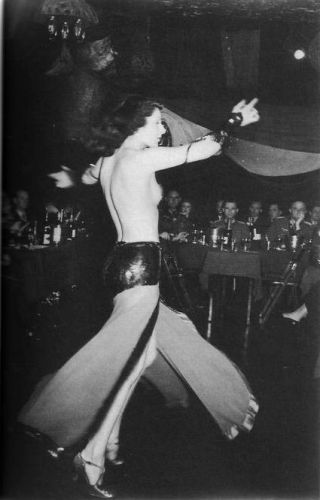
Image: Parisian dancer in front of German officers, 1944 (from the collection of Roger Schall/Madame R. Schall)
Jean Genet observed that the creative act was like that of a tightrope walker, always in danger of falling from the wire in the act of performance:
You will experience a bitter period - a sort of Hell - and it will be after this crossing through a darkened forest that you will emerge, the master of your art... . This is one of the most moving mysteries of all.
Guyotat is a performative showman of his own body as well as a self-negating, peripheral figure, and he asserts, in Coma, that what he is trying to do is to project unprecedented forms of language: 'No one before me, and in this language, has written as I write, as I dare to write, and as it is my pleasure and my plenitude.' But that new language is a very dissimilar one, inflected by a more fragmentary, denuded corporeal form, from his linguistic and sexual experimentations of the 1960s that provoked scandal and censorship. Coma is a book within which language falls into an abyss, along with the body that writes it - what emerges, after that shattering, sees itself as being identical to every other body and language, but, through the very act of imagining such an infinitely conjoined body and language, remains terminally apart and unprecedented: a vital aberration.
Stephen Barber <stephenbarber AT yahoo.com> is a professor at Kingston University' Visual and Material Culture research centre, and currently a Fellow of the DAAD in Berlin. He is the author of many books, most recently Abandoned Images, London: Reaktion, 2010 and Hijikata: Revolt of the Body, Chicago: Solar, 2010
INFO:
Pierre Guyotat, Coma, Los Angeles: Semiotext(e), 2010
Mute Books Orders
For Mute Books distribution contact Anagram Books
contact@anagrambooks.com
For online purchases visit anagrambooks.com






